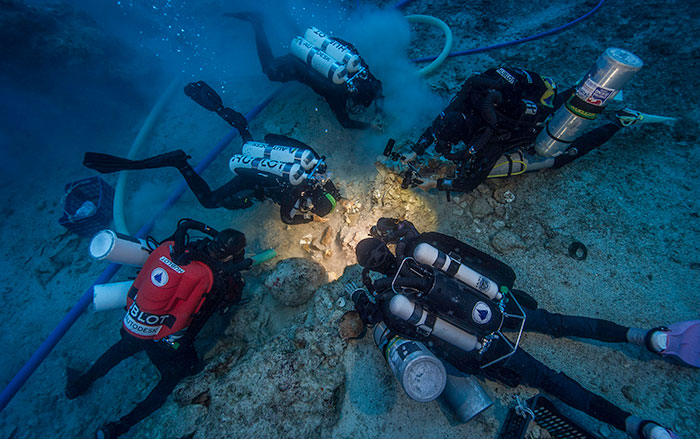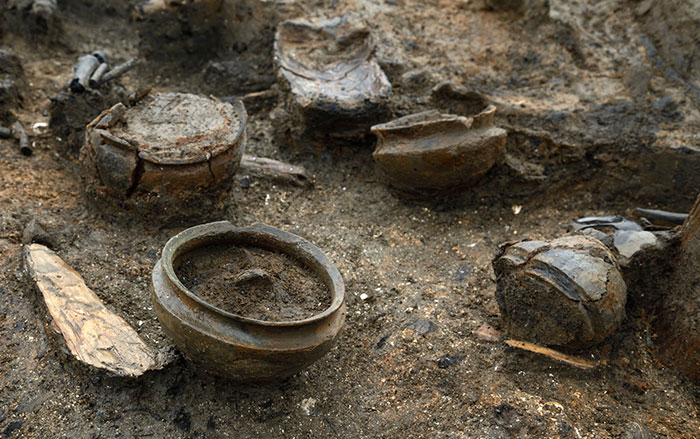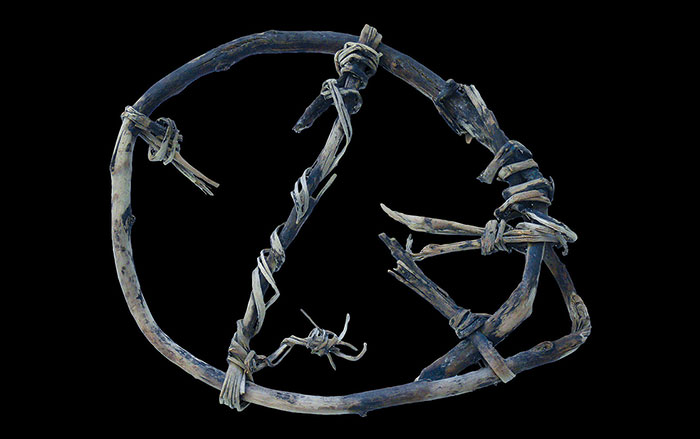In the landlocked Southeast Asian nation of Laos, thousands of massive stone jars dot the Xieng Khouang Plateau. Scattered across 2,100 square miles of steep slopes, grassy fields, and forested foothills, these ancient megaliths create an archaeological landscape known as the Plain of Jars. The jars, more than 2,000 in all, are distributed across at least 80 sites—some with just a few, others with nearly 400. Most jars sit on mountain slopes, and the largest, which can be as much as nine feet tall and six feet in diameter, are found in highland locations above 3,600 feet. The majority are carved from sandstone, and geologists estimate the heaviest weigh 25 tons or more. One of the biggest assemblages is found at a location called Site 1, where 344 jars sit in wide-open spaces on the windswept plains outside the town of Phonsavanh, the capital of Xieng Khouang Province.
Intriguingly, almost nothing is known about the people who created the jars 1,500–2,500 years ago. They left no written texts, inscriptions, domestic structures, or habitation sites. Few excavations have been conducted, and not many bodily remains have been found, compounding uncertainty about their identity, beliefs, and practices. Now, a newly formed five-year project funded by the Australian Research Council, Unraveling the Mysteries of the Plain of Jars, has come to northern Laos and is combining traditional archaeological excavations with new research technologies to create a picture of the people who have remained such an enigma for so long.
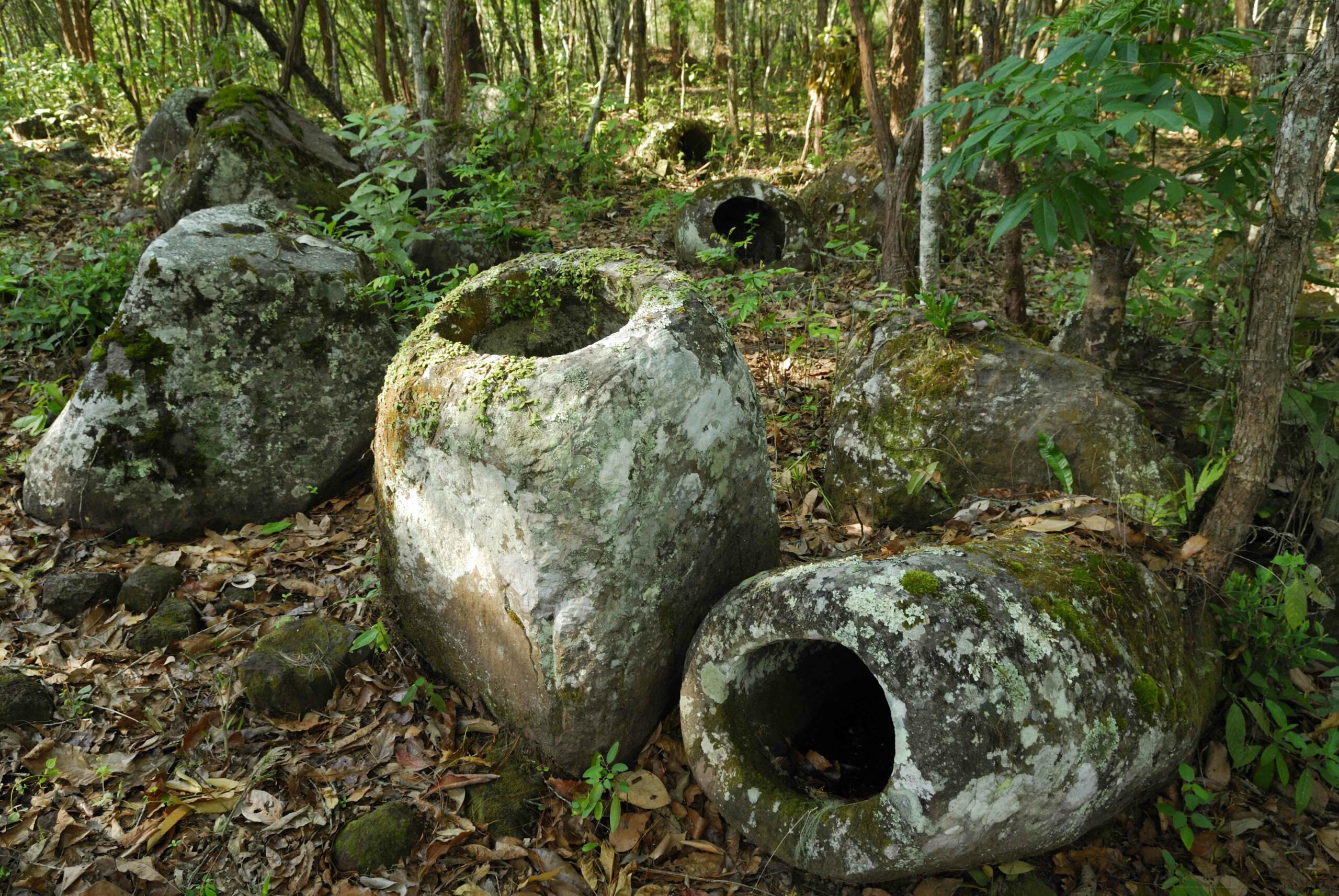
In February 2016, the team conducted its initial digs at Site 1 during an unusually frigid stretch of winter weather. One windy morning, archaeologist Louise Shewan of Monash University crawled across the ground, still damp after a drenching rain, into a pit only 6.5 by 6.5 feet. She grabbed a trowel and began to work beside two Polish researchers, one of whom was Joanna Koczur from the University of Szczecin. “Please don’t rain,” said Koczur. “Yesterday it was just crazy—it was like a swimming pool in here.”

The three scraped away the red earth using brushes and tiny picks designed for precision. Their work centered on a round object on the packed dirt floor, which Koczur had found the day before. They worked meticulously to reveal more of what lay beneath. At first the object resembled a rock, smooth on top and caked with mud on the underside. But it was not a rock at all; rather, it was a small orb of bone, part of a fragile human skull, which they later named “Burial 5.” The skull was surrounded by other bits of bone, so maneuvering around the trench among the delicate remains was difficult and physically demanding. “After five minutes in the same position, you are so stiff you can’t move,” said Koczur, who was dressed in layers of hats and jackets. Later that day, the team uncovered fragments from a second skull, and skull fragments and the mandible of a child. “Multiple burials in the same place are pretty fascinating,” says project director Dougald O’Reilly of the Australian National University, especially when up to this time scholars studying this area had found so few.
By the end of the first season, more bones and numerous teeth had been uncovered from at least six burials of three types: primary burials, where the location is the original burial spot; secondary burials, a common form of burial rite often associated with megaliths, in which the remains have been reinterred; and, finally, inhumation jars, which are buried ceramic vessels containing bones. This variety adds to the complexity of the site and offers researchers the opportunity to consider questions they had never been able to examine before: Were the burial types contemporaneous? How long was Site 1 used as a mortuary landscape? Do the different types of burials belong to different segments of the society? Is this variation repeated at other sites across the plain? Were the people who carved the jars local, or were they visitors from a faraway place?
While many of the bones are in poor condition and extremely brittle, the teeth, which are in better shape, can be very useful in beginning to respond to some of these questions. Shewan intends to conduct isotopic analysis of the teeth to determine whether the people who created the jars came from the area. By comparing the strontium isotope ratio in the teeth with that of the local soil, plants, and water in the region, and in animal teeth from nearby archaeological deposits, researchers can tell if a person had obtained their food and resided locally.

Twenty years ago, the Plain of Jars was even less accessible than it is now. Back then, travelers—few and far between—arrived on noisy, old Soviet twin-turboprop Anatovs, or on all-day overland rides through the twisting, precipitous mountainous terrain outside Phonsavanh, about five miles from Site 1. For years, Phonsavanh was a rough, dusty town that went to sleep by 10 p.m., when the electricity quit. Today it’s still a small city of about 37,000 people, but power stays on 24 hours a day, ATMs dispense Lao currency, trucks and motorcycles roar through the streets and stop at newly installed traffic lights, and most people have access to the Internet. There are also more visitors now, with restaurants, bars, and hotels catering to them. Yet Phonsavanh still doesn’t attract the influx of tourists seen at the Lao capital, Vientiane, or at the ancient city of Luang Prabang, a UNESCO World Heritage site known for its gilt Buddhist temples. “It astounds me how few people know about this fantastic archaeological landscape,” says Julie Van Den Bergh, a Belgian archaeologist who spent years working with UNESCO and the Lao government to protect the area’s cultural heritage and to prepare it for World Heritage status and sustainable tourism. Only a very few archaeologists have ever excavated on the Plain of Jars and, therefore, precious little is known about the people who inhabited the plain. Yet, piece by piece, scientists have begun to assemble the story of how they were honored in death. Scholars now agree that the Plain of Jars is a prehistoric mortuary landscape composed of the burials of people who likely lived during Southeast Asia’s Iron Age, between 500 B.C. and A.D. 500.
However, it is not just the scarcity of remains or the poor condition of the few bones that have been found that has hindered investigation. Research has long been hampered by the extreme remoteness of the jar sites, as well as the danger in reaching them. The Plain of Jars has, at times, been called the world’s most dangerous archaeological site. In the 1960s and 1970s, during the Vietnam War, the area was pummeled with American-made bombs. It was a prime target during the U.S. bombing campaign in Laos, when Xieng Khouang was ground zero in the fight between the North Vietnam–backed Pathet Lao communist insurgency and the United States–backed Royal Lao Government.
From 1964 to 1973, more than two million tons of bombs (including more than 270 million cluster bombs) were dropped on Laos, more than on all of Europe during World War II. An estimated 80 million of those bombs did not explode when they fell, and they continue to imperil the lives of people throughout the country. Of the millions of bombs remaining in the soil, the majority are small submunitions, often called “bombies,” which are about the size of baseballs—but deadly nonetheless. They frequently look like rocks, indistinguishable from the surrounding terrain. Bombies make digging, both for farmers and for archaeologists, very dangerous. “It’s hard to even comprehend the scale of destruction that was wrought here,” O’Reilly says. “You can still see bomb craters in the ground. And many of the jars were blown over or smashed by the bombing. Fortunately, though, the majority of the jars weren’t destroyed.” Every day in Laos, people still find bombs. And every year, dozens of Laotians are injured or killed by them. “We don’t have any interest in working at sites that haven’t been cleared,” O’Reilly says. “It’s just too dangerous. It’s frightening. You have to be vigilant and stick to the paths.” Xieng Khouang remains one of the most heavily contaminated provinces, and the presence of so many bombs continues to be one of the greatest challenges both to further study and development throughout the region.
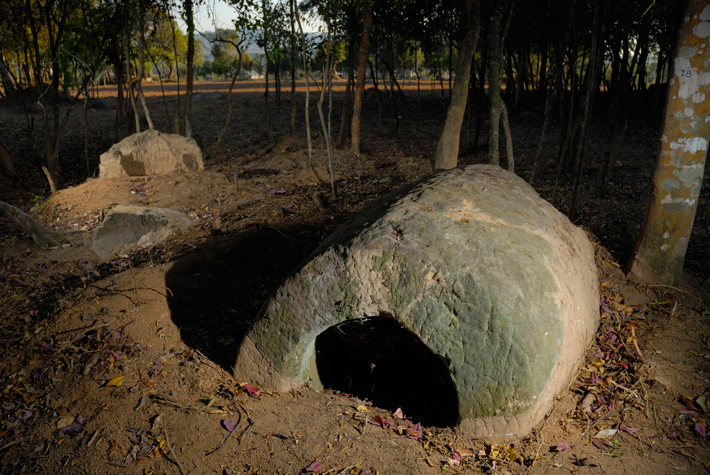
When Van Den Bergh worked on the Plain of Jars between 2001 and 2010, she did so alongside the Britain-based Mines Advisory Group, which cleared bombs from seven of the sites with the greatest potential for tourism. Although she spent several years in Xieng Khouang, Van Den Bergh was not able to excavate because her project was classified as research, and she didn’t have government permission to dig at the time. However, her team was able to map more than 80 jar sites using tape measures, compasses, and handheld GPS devices, and to make traditional paper surveys. “Most of our photographs are pre-digital, too,” she says.
The team began by visiting villages across the province and asking whether locals knew of any jars. Every time someone said “yes,” team members surveyed the site. The results, Van Den Bergh says, pushed researchers to view the bigger picture and recognize the individual sites as components of a whole. “Jar sites are mainly on the edge of the central plateau and on the slopes of the inland valleys connecting to east, west, and south,” she explains. When taken together, the seemingly disparate sites on the Plain of Jars appear to form a complex interconnected landscape.
Today, Shewan and O’Reilly, along with Thonglith Luangkhoth, their partner from the Department of Heritage at the Lao Ministry of Information, Culture, and Tourism, are conducting extensive research using more technologically advanced tools than were previously available to examine another mystery—how the massive jars were created and then set in place. “The jars themselves are quite impressive,” says O’Reilly. “You can’t even get your arms around them.”
Geological research conducted by Van Den Bergh suggests the jars were carved from existing blocks of stone in quarries close to each jar site. Eight years ago, a British geologist named Jeremy Baldock, who was recruited to help Van Den Bergh’s project, took measurements on a shady ridge called Phou Hin Moung, several miles southeast of Site 1 near a village called Ban Buatai. His aim was to create a 3-D model of the quarry in order to estimate the possible number of blocks that could have been taken from the site. Baldock determined that the quarry could have been the source for 57 blocks that were used to fashion 37 jars found in the nearby village, along with eight others scattered around the area.

During this work, Van Den Bergh and Baldock also learned that the jar makers understood geological principles such as tectonics and sedimentation. “They approached areas of bedrock that had naturally fractured in large rectangular blocks,” says Van Den Bergh. “This might mean that the size of the jars is likely less an expression of status than of the size of available blocks.” Still, it’s clear to researchers that the jars reflect importance in some manner. “The logistic and time investment alone—for jars of all sizes—indicates how people felt about their community and the importance of mortuary ritual,” Shewan says. “People are consciously ascribing significance to their burial landscape.”
The quarry nearest the team’s initial excavation pits at Site 1 is about five miles away from the Site 1 jars. Investigating how the jars were moved will be a focus of upcoming seasons. “The jars may have been dragged or rolled—we don’t know,” Shewan says. “However, the logistics required to shift up to 25 tons of carved rock must have had an impact on the landscape somewhere.” She hopes to use lidar in the future to virtually strip away the tree canopy and grass to look for drag marks or gouging in the topography and to map possible transportation routes. Being able to examine the ground free of growth—a task that, in the past, required local volunteers with machetes—will allow her to look for evidence that would indicate where or how the jar people could have lugged multi-ton rocks across miles of downward-sloping terrain between quarry sites and jar sites. “It must have required a huge amount of effort to produce them and bring them from the quarry,” O’Reilly adds. “It’s an incredible feat.”
Ever since pioneering French archaeologist Madeleine Colani first explored the region in the 1930s, many sites on the Plain of Jars have become even more inaccessible to scientists. But today, technology enables what was previously inconceivable. “We are fortunate to have a suite of recording methodologies and innovative analytic tools,” Shewan says. “Colani’s corpus of research is truly inspiring; it makes you realize what we take for granted.” In addition to the isotopic analysis of skeletal remains from Burial 5 and the child found nearby, the team is geo-mapping every jar and every associated archaeological feature to create an extensive and expandable GIS database.
They are also using drones to design an interactive 3-D presentation for a Monash University–funded project called CAVE2. The CAVE2 room consists of a curvilinear wall with 80 high-definition screens, a high-powered computer that enables 30-frames-per-second playback of 84-million-pixel images, delivering one trillion computations per second for each of the 80 screens. Visitors wear lightweight 3-D glasses to explore all of the team’s digital data. “You can actually walk through the landscape,” Shewan says. “Being in CAVE2 places you right in the middle of the Plain of Jars, excavating alongside us at Site 1. We can measure distances between the jars, walk amongst them, step into the excavation trench to continue our research, and zoom in to areas of interest. We can watch the removal of each 10-centimeter layer, revealing the artifacts and burials as each layer is peeled away.” The best use of CAVE2 is yet to come, says Shewan, when drones will gather data from bomb-riddled sites too dangerous to explore in person.
In February 2017, the Unraveling the Mysteries team will return to Laos, to the high-elevation Site 52. It’s about 20 miles from Site 1 as the crow flies, but twice that distance by vehicle or foot. “Site 1 is the anomaly,” Shewan says, “being on a flat, cleared plain.” Site 52 sits near a modern-day Hmong village called Ban Pakeo. Only six years ago, the trek to Ban Pakeo took most of a day of hiking on a steep trail that branched off an old road. Now a new road brings visitors much closer. Van Den Bergh and her team previously measured and mapped the jars there, but no one has ever excavated. “Site 52 is untouched by any researchers, so it’s going to be quite exciting,” Koczur says.

The site encompasses four known jar groups, the largest of which contains at least 371 fine-grained sandstone jars, as well as a number of stone discs of the type often found at jar sites. “Sometimes those stone discs are said to be lids,” says O’Reilly, “but I don’t believe that they are. I think they are burial markers.” The team will also be looking for any skeletal material for DNA comparisons and isotopic analysis, as well as grave goods such as tools, beads, or ceramics that might be evidence of trade.
Despite all this—new research tools and technologies, better access to sites, and the somewhat decreased threat of unexploded ordnance—so many questions remain. But stand on a mountaintop or fly over Xieng Khouang, and it’s easy to see—the ancient jars will remain a defining presence across this land.
Karen Coates is a senior fellow at Brandeis University’s Schuster Institute for Investigative Journalism. Her latest book, with Jerry Redfern, is Eternal Harvest: The Legacy of American Bombs in Laos.








